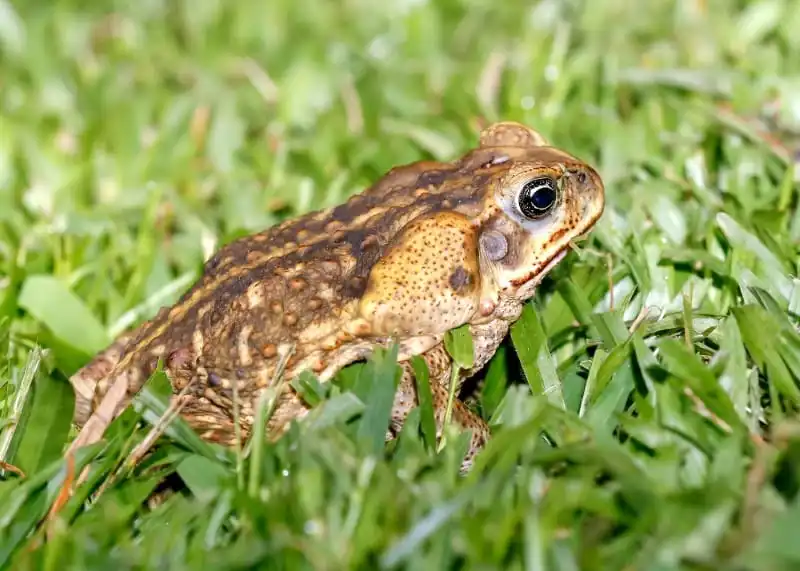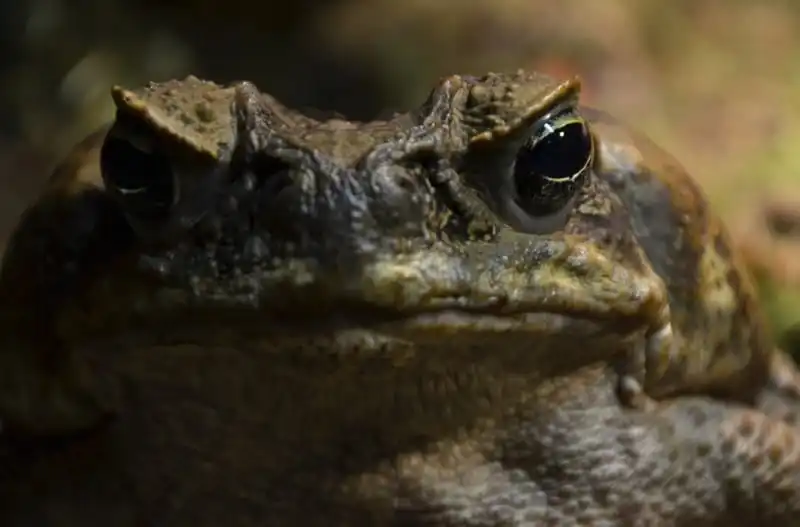What you need to know about the cane toad
Toads have always frightened many people; their large size, rough and warty skin, and the large venom bags on the sides of their heads are the main reasons for this aversion.
What is unknown to a large part of the population is that, in fact, there are about 90 frog species of the same genus (of the same “family”) as the cururu toad - found from Mexico and all over South America.
In Brazil we can find about 36 species, which can measure from a few centimeters to 25 cm (10 inches)1 2.
Although to the untrained eye they may all look the same, not all frogs of this genus (Rhinella) have large venom sacs, known as paratoid glands - yet many (if not all) of them are poisonous.3 Some, are small, beautifully patterned, and may even have protuberances on their heads that resemble large ears.
The cane toad (Rhinella marina) is found from Florida to Bolivia, occupying the entire Amazon rainforest. In addition to the cane toad, some of the largest and most common species in Brazil are: the yellow cururu toad (R. icterica), and the cururu toad (R. diptycha).
The famous cururu toad call attention for being the largest frogs in Brazil, although they usually reach about 15 cm (6 inches), some individuals with 25 cm (10 inches) have been found. The males are completely yellow, while females and juveniles can be yellow or brown with black spots on the back.
Cane toads and cururu toads are terrestrial, nocturnal animals and can be found all over the country - including in urban areas.4 They can be seen on sidewalks or in backyards to feed on insects, small vertebrates, and, depending on the species, even pet food.

It is true that these toads have poison. However, cane and cururu frogs do not squirt poison and are not capable of poisoning someone voluntarily - simply touching the frog will not cause poisoning. The only way to be poisoned is to squeeze its venom glands, force the poison out, and ingest it.
Depending on the amount ingested, it can cause nausea, vomiting, paralysis, and rarely death5 The venom can also cause adverse reactions such as discomfort and burning if it comes in contact with mucous membranes such as the eyes or gums.
Therefore, these toads are considered practically harmless to humans, as poisoning depends on a number of specific and unlikely factors. However, care should be taken with pets as they may be affected if they attempt to bite the frog.
Its venom is actually only used as a defense mechanism when an animal tries to eat it. For example, when snakes try to bite it, they end up squeezing its glands and the poisonous fluid inside is expelled directly into the mouth of the predator, causing discomfort and causing it to get rid of the frog immediately.
Nevertheless, the cane toad is part of the diet of many animals that are tolerant to its toxins, such as the broad-snouted caiman (Caiman latirostris), several snakes and birds6. The great black hawk (Buteogallus urubitinga), for example, knows not to eat certain parts of the cane toad.

Although toads are avoided and often killed for no reason, they are studied by many scientists for the properties of their venom, which, when isolated in the laboratory, can be used to create and improve many remedies, including those for leishmaniasis, Chagas disease,7 malaria8 and several other diseases.
In addition, cane toad are important biological control agents because they also feed on invertebrates that can be harmful to humans and crops, such as flies, mosquitoes, and scorpions9 - helping to keep their numbers in check.
References:
-
OCP News - Agricultores encontram sapo gigante raro em Guaramirim ↩︎
-
Capela, Danilo & Struett, Michelle & Leivas, Peterson. (2020). Predation attempt of Rhinella ornata (Spix, 1824) Anura, Bufonidae) by Leptodactylus cf. latrans (Anura, Leptodactylidae) in the Atlantic Forest, Brazil . Herpetology Notes. 13. 11-13. ↩︎
-
Salvador, S. A., and Néstor Fariña. “Anfibios y reptiles como parte de la dieta de las aves de Argentina, una recopilación .” ↩︎
-
Banfi, F. F., Krombauer, G. C., Fonseca, A. L. da ., Nunes, R. R., Andrade, S. N., Rezende, M. A. de ., Chaves, M. H., Monção Filho, E. dos S., Taranto, A. G., Rodrigues, D. de J., Vieira Júnior, G. M., Castro, W. V. de ., Varotti, F. de P., & Sanchez, B. A. M.. (2021). Dehydrobufotenin extracted from the Amazonian toad Rhinella marina (Anura: Bufonidae) as a prototype molecule for the development of antiplasmodial drugs. Journal of Venomous Animals and Toxins Including Tropical Diseases, 27(J. Venom. Anim. Toxins incl. Trop. Dis, 2021 27). https://doi.org/10.1590/1678-9199-JVATITD-2020-0073 ↩︎
-
Amazonas atual - Em risco de extinção, sapo-cururu pode ajudar no combate ao escorpião-amarelo ↩︎
